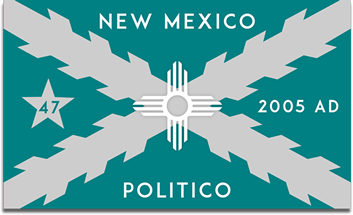Last night’s municipal elections in Las Cruces saw progressives claim victory in every race they participated in, which also saw a roughly 2% increase in voter participation from that last time those districts held elections (so much for an anti-Trump backlash). Turnout barely broke into the double digits unlike Albuquerque’s historic 29% turnout last month.
In other races across the country Democrats also had a really good night, winning the gubernatorial races in New Jersey and Virginia. While it is noteworthy that in Virginia Ralph Northam won by a larger margin than most polls predicted, the outcome of both races largely met expectations: midterm elections usually have positive results for the opposing party due to a favorable environment (and it did not help Republicans to have an incumbent President with a 37.6 approval rating).
Are those electoral results a harbinger of future elections? It depends. For Republicans in New Mexico the takeaways are different than those outside the state.
New Mexico GOP
In Las Cruces, Republican candidates suffered because of a lack of organizational, financial, and ground game support. Recently elected Doña Ana County Chair Betty Bishop has tried to organize a county party that has struggled to find its stride in recent years and has been in office for just over a month. As far as I know only two paid staffers assisted some of the GOP campaigns in Las Cruces (there was no assistance from the state GOP party) which were paid by the Southern Business Alliance and Advance Las Cruces.
This is in comparison with the state Democratic Party who had at least one full time field organizer deployed. According to a DPNM press release in Las Cruces they had setup “a campaign headquarters where volunteers could connect with an organizer to knock on doors or make phone calls.” But by far the leftist group with the largest local impact is Don Kurtz and the Progressive Voter Alliance who have been well organized for years in Doña Ana County.
The lack of a well-established GOP GOTV machine has and will continue to severely limit the electoral success of GOP candidates in Las Cruces. While conservative outside groups have spent large sums of money on races in Dona Ana County in the past, this has mostly been on mailers and other paid media.
In the three city council races for 2017 the voter turnout was 9.3% for District 3, 13.4% for District 5, and 17.3% for District 6. With such a low percentage of the voting population active it is fairly easy for progressives to win when one side has a polished ground game and the other side’s is non-existent. This is clearly a concern to any statewide GOP candidate in 2018.
Next week’s mayoral election in Albuquerque is already a foregone conclusion but it is unlikely Dan Lewis’s expected loss is due in any large part to Trump’s unpopularity in New Mexico or even a motivated Democratic base. The GOP’s inability to coalesce behind one candidate, Tim Keller’s well organized ground game, Mayor Berry’s unpopularity, and Albuquerque’s high crime are factors with much greater impact.
National GOP
The highest profile race of 2017 was easily the Virginia governor’s race. Democrats made sure to minimize expectations of a race that was tightening going into election night. And it is hard to blame them: they have consistently fallen short in special elections across the country.
After Ralph Northam claimed victory in Virginia New Mexico Congressman Ben Ray Luján (who is the chair of the Democratic Congressional Campaign Committee) tried to capitalize on the momentum. “Doesn’t matter if you’re watching CNN, Fox News, or MSNBC: There’s good news for Democrats… The House is absolutely in play; everything is absolutely moving in our direction,” Luján said.
But no matter how much the Congressman tries to spin it the 2018 cycle continues to contain significant challenges to Democrats. In order to flip the U.S. House they have to flip 24 Republican-held seats, and in the U.S. Senate they will have to defend 10 incumbent senators running for reelection in states that Trump won last year (not to mention the intraparty policy divisions threatening their party unity).
But make no mistake about it: Tuesday’s results in Virginia and New Jersey were due to “an unmistakable anti-Trump backlash”. The “anti-Trump” coalition in Virginia was made up of upper-scale white voters, millennials, minorities, suburban women and single women who came out in greater numbers last night than they did for Hilary Clinton a year ago. Ed Gillespie actually performed better in red districts in Virginia than Trump did in last year’s presidential election but it wasn’t enough to counter the surge in turnout by the “anti-Trump” coalition.
Turnout in Virginia went up the most in blue precincts with lots of college educated voters. pic.twitter.com/vOtRxU1u8n
— Patrick Ruffini (@PatrickRuffini) November 8, 2017
The chart above shows both the increase in turnout of blue districts and the surge of college educated voters in Virginia. The entire map of Virginia districts below shows that there were no districts that swung from Democract to GOP between last year’s election and last night’s election.
The Virginia maps of 2017 (top-Northam/Gillespie) & 2016 (bottom-Clinton/Trump) are basically the same (NYT maps) pic.twitter.com/2VqyDKARei
— Jamie Dupree (@jamiedupree) November 8, 2017
Simply put, the Democrats were motivated while the Republicans were not. As those graphics show, despite the fact that Democratic voters were energized and over performed compared to last year, the Virginia electoral map as a whole did not change.
For national Republicans there are essentially two takeaways.
First, in the words of Stephen Bannon, “Trumpism without Trump” does not work. In other words it is not possible to mobilize Trump’s GOP base by embracing Trump’s ideas and not the man himself.
The second point is related to Congressman Luján’s victory lap last night. Is he getting ahead of himself or is his 2018 analysis correct? The answer is mixed. Northam’s considerable strength among the so called “anti-Trump” coalition voters could be a warning sign to the GOP in states containing suburbs in and around large cities that are important to maintaining control of Congress. But as I mentioned earlier they face considerable headwinds to secure victory (such as needing to flip 24 Republican-held seats in the House). And if Republicans are able to actually get something done such as tax reform or healthcare that could go a long way towards making a case for why they deserve to maintain control of Capitol Hill.
With a year to go a lot can happen, which could help or hurt the GOP. As Speaker Paul Ryan mentioned this morning, the pressure is on Republicans in Washington to get something done.

